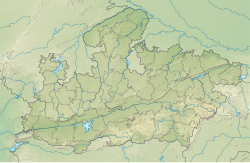Padmavati, identified with modern Pawaya in Madhya Pradesh, was an ancient Indian city mentioned in several classic Sanskrit texts, Malatimadhavam of Bhavabhuti,[1] Harshacharita of Bana,[2] and Sarasvatīkaṇṭhabharaṇa of Raja Bhoja. Bhavabhuti describes the city with tall mansions and temples with shikharas and gates, located between Para and the Sindhu rivers.
Padmavati (Pawaya) | |
|---|---|
city | |
| Coordinates: 25°46′N 78°15′E / 25.77°N 78.25°E | |
| Country | |
| State | Madhya Pradesh |
| District | Gwalior |
| Elevation | 305 m (1,001 ft) |
| Languages | |
| • Official | Hindi |
| Time zone | UTC+5:30 (IST) |


It is also mentioned in inscriptions like the Kokkala Grahapati inscription of Khajuraho.[3] The inscription mentions that the city had rows of tall mansions. The dust used to arise because of running of strong horses.[4]
Identification
editAlexander Cunningham identified Padmavati with present Narwar near Gwalior.[5] M B Garde carried out excavations at Pawaya in 1924-25, 1933–34 and 1941. He identifies Pawaya with ancient Padmavati rejecting Cunningham’s identification with Narwar.[6][7] Coins of several Naga kings, who have been dated between 210-340 AD, have been found at Pawaya.
Antiquities
editAmong the antiquities found at Pawaya is an image of Yaksha Manibhadra.[8] It has an inscription that mentions that it was installed in the fourth regnal year of King Sivanandi and was worshipped by the gosthas or merchants.
See also
editReferences
edit- ^ Bhavabhūti: His Date, Life, and Works By V. V. Mirashi, p. 74, The History of Padmavati
- ^ Rise And Fall Of The Imperial Guptas, Ashvini Agrawal, Motilal Banarsidass Publ., Jan 1, 1989 p. 54
- ^ Khajuraho, Kanhaiyalal Agrawal, Macmillan India, 1980 (in Hindi)
- ^ Padmavati Purval Digambar Jain Jati ka Udbhav aur Vikas, Ramjit Jain, Pragatishil Padmavati Purval Digambar Jain Sangathan Panjikrut, 2005, p. 15
- ^ Cunningham, Alexander (1872). Four Reports Made During the Years 1862-63-64-65 (Vol II). Archaeological Survey of India. New Delhi.
- ^ INDIAN ARCHAEOLOGY 1955-56 EDITED BY A. GHOSH, Director General of Archaeology in India, DEPARTMENT OF ARCHAEOLOGY, GOVERNMENT OF INDIA, NEW DELHI, 1956.
- ^ Costumes & Ornaments As Depicted in the Early Sculpture of Gwalior Museum By Sulochana Ayyar, p. 20-21
- ^ Jaina-Rupa-Mandana, Volume 1, Umakant P. Shah, 1987, Page 205
External sources
edit- Pawaya – Glamour of the Ancient Padmavati, http://puratattva.in/2011/07/11/pawaya-glamour-of-the-ancient-padmavati-159.html

